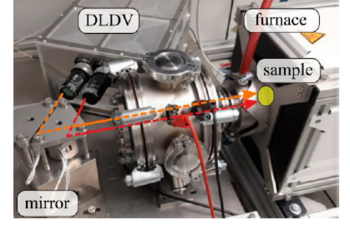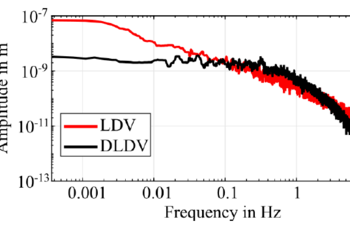Laser Doppler vibrometry with high resolution in the frequency range below 10 Hz
This research was funded as part of the DFG project "Chemical expansion of praseodymium-cer mixed oxide films at high temperatures" (project number 404875250).
Motivation
In industrial manufacturing and energy supply, high-temperature processes are becoming increasingly relevant. In this context, there is a need for sensor/actuator systems. However, available sensor/actuator systems, such as piezo elements, can only be used to a limited extent due to insufficient operating temperatures. A promising alternative is the chemical expansion of volume crystals such as praseodymium cerium mixed oxides (PCO), which generate strong reversible strain as a function of temperature or oxygen activity. In this process, the oxygen activity can also be controlled with a voltage using a suitable substrate. The underlying processes are very slow and the vibrations are in the millihertz range with displacements of a few nanometers. Laser Doppler vibrometers (LDVs) are suitable for measuring the displacement caused by the chemical expansion. However, commercially available LDVs are limited by strong low-frequency noise due to environmental disturbances (such as heat haze and mechanical vibrations).
Methods
The goal of this DFG-funded project is to develop a suitable measurement method that enables the measurement of vibrations in the millihertz range. For this purpose, it is necessary to analyze low-frequency noise sources in the frequency range from a few mHz up to about 10 Hz. For compensation of the environmental disturbances, a differential laser Doppler vibrometer (DLDV) was developed, which can significantly decrease noise from environmental disturbances.
The measurement setup for the investigation of the chemical expansion using the developed DLDV, which was realized in cooperation with the research group for high temperature sensor technology at IEPT, is shown in the following figure:
Hierbei werden der Mess- und Referenzstrahl des DLDVs über zwei Stellspiegel auf der im Hochtemperaturofen befindlichen PCO-Probe positioniert. Durch die differentielle Messung können Störungen durch Umgebungseinflüsse so signifikant reduziert werden. Dies ist im nachfolgenden Spektrum verdeutlicht.
Here, the measuring and reference beams of the DLDV are positioned by two adjustable mirrors on the PCO sample located in the high-temperature furnace. Due to the differential measurement, disturbances caused by environmental effects can be significantly reduced. This is illustrated in the following spectrum.
Publications:
- M. Schewe, D. Kohlmann, H. Wulfmeier, H. Fritze, C. Rembe:
Differential laser Doppler vibrometry for displacement measurements down to 1 mHz with 1 nm amplitude resolution in harsh environments
In: Measurement, p. 112576, 2023. DOI: 10.1016/j.measurement.2023.112576. - D. Kohlmann, H. Wulfmeier, M. Schewe, T. Defferriere, C. Rembe, H.Tuller, H. Fritze:
High-temperature chemical expansion of Pr0.1Ce0.9O2-δ thin films determined by Differential Laser Doppler Vibrometry
In: Solid State Ionics. vol. 392, p. 116151, 2023. DOI: 10.1016/j.ssi.2023.116151. - D. Kohlmann, H. Wulfmeier, M. Schewe, I. Kogut, C. Steiner, R. Moos, C. Rembe, H. Fritze:
Chemical expansion of CeO2−δ and Ce0.8Zr0.2O2−δ thin films determined by laser Doppler vibrometry at high temperatures and different oxygen partial pressures
In: Journal of Materials Science. vol. 58, p. 1481-1504, 2023. DOI: 10.1007/s10853-022-07830-4. - M. Schewe, D. Kohlmann, H. Wulfmeier, H. Fritze und C. Rembe:
Methoden zur Minimierung des Rauscheinflusses durch Hitzeflimmern bei einem heterodynen Laser-Doppler-Vibrometer
In: tm - Technisches Messen. Vol. 87, Issue s1, pp. 44-49, Aug. 2020. DOI: 10.1515/teme-2020-0023 - D. Kohlmann, H. Wulfmeier, M. Schewe, C. Rembe, H. Fritze:
Chemische Ausdehnung von Sensor- und Elektrolytmaterialien bei hohen Temperaturen
Konferenzbeitrag: 15. Dresdener Sensor-Symposium 2021. DOI: 10.5162/15dss2021/7.2.
Since in some samples rough surfaces occur, the use of signal diversity to reduce the influence of speckle effects has also been investigated in two publications:
- M. Schewe and C. Rembe:
Signal Diversity for Laser-Doppler Vibrometers with Raw-Signal Combination
In: Sensors 2021, 21(3), 998, DOI: 10.3390/s21030998. - M. Schewe and C. Rembe:
Analyzing real-time capability of raw laser-Doppler vibrometer signal combination for signal diversity
In: Proc. SPIE 11782, Optical Measurement Systems for Industrial Inspection XII, 117820E (20 June 2021), DOI: 10.1117/12.2592048.
![[Translate to English:] [Translate to English:]](/fileadmin/_processed_/b/2/csm_KT_MPV_1a049c53c4.jpg)

